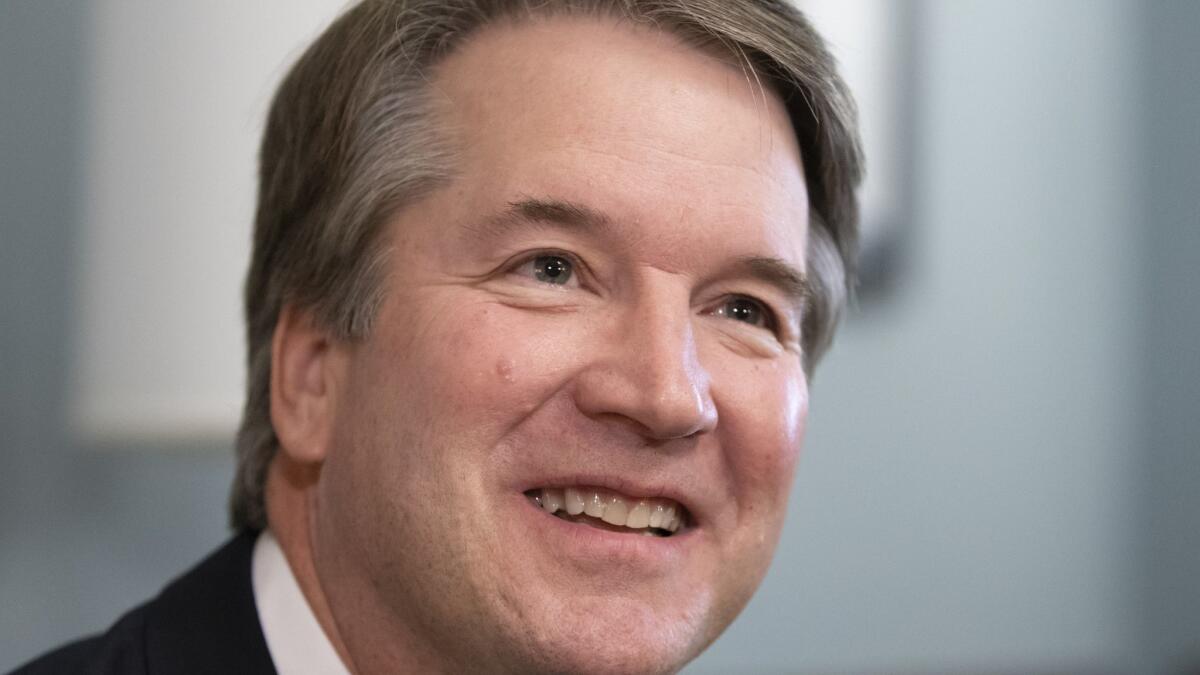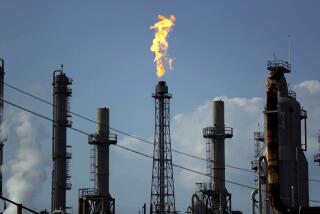Judge Kavanaugh could give conservatives the vote they need to rein in EPA rules on climate change

- Share via
Reporting from Washington — In its most important environmental ruling of recent decades, the Supreme Court decided in 2007 that the greenhouse gases blamed for warming the planet can be regulated as air pollutants under the Clean Air Act of 1990.
It was a pivotal opinion that opened the door for the Environmental Protection Agency to impose new regulations on autos, power plants, manufacturers and others, to address climate change as well as the dirty air targeted by the original law.
But it came on a 5-4 vote, with Justice Anthony M. Kennedy joining the four liberals and over a fierce dissent by Chief Justice John G. Roberts Jr.
Now as federal appellate Judge Brett M. Kavanaugh seeks to replace the retiring Kennedy on the Supreme Court, Kavanaugh’s 12-year record of skepticism toward such agency actions puts the landmark decision and other environmental protections at risk. Environmentalists fear that if Kavanaugh joins the court, he would vote to block anti-pollution regulations for decades, long after President Trump has departed.
“He would be a disaster for the environment,” said Pat Gallagher, legal director for the Sierra Club. “He has a disdain for regulation, particularly from the EPA. Kennedy was the swing vote in this area. If we have to wait for Congress to act on climate change, we are doomed.”
While serving on the U.S. Court of Appeals for the District of Columbia, President Trump’s nominee for the Supreme Court has been a steady “no” vote on climate change regulations.
When joined by fellow conservatives, he wrote opinions rejecting EPA rules to limit greenhouse gases or air pollution that blows across state lines. And when the majority upheld regulations, including limits on power plants that pump out carbon pollution or put toxic mercury in the air, Kavanaugh filed long dissents, usually arguing that Congress, not the EPA, is the only body with the power to take such steps.
“EPA’s well-intentioned policy objectives with respect to climate change do not on their own authorize the agency to regulate,” he wrote last year in a 2-1 ruling that struck down a rule that required makers of air conditioners, refrigerators and aerosols to phase out the use of hydroflourocarbons, or HFCs. These chemicals are powerful producers of heat-trapping gases, about 1,300 times more than carbon dioxide. Safe substitutes are now on the market, EPA said.
Kavanaugh’s opinion in Mexichem Fluor vs. EPA was a victory for a Mexican chemical company that produces the outdated, but cheaper, HFCs. By contrast, the largest American firms in the market, led by Honeywell, joined in support of EPA’s rule, noting that they had invested more than $1 billion in the new generation of refrigerants. In late June, two days before Kennedy announced his retirement, lawyers for Honeywell and the Natural Resources Defense Council filed separate appeals in the Supreme Court urging the justices to overturn the 2-1 ruling.
“His decision has utterly crippled this program and left EPA with no way to curb HFCs,” said David Doniger, a lawyer for NRDC.
Kavanaugh insisted the case was about the “separation of powers,” not environmental rules. “Congress’s failure to enact general climate change legislation does not authorize the EPA to act,” he wrote.
It is a familiar theme of his opinions. He is deeply skeptical of costly government regulations, and especially so when Congress has not spoken clearly.
UCLA law professor Ann Carlson, who teaches environmental law, describes him as a “more polite version of Justice [Antonin] Scalia. He will acknowledge the existence of climate change, say that it’s a compelling public policy problem, say that Congress could and should do something, and then eviscerate EPA’s attempts to address the problem.”
Conservatives applaud Kavanaugh’s approach and argue he is enforcing the Constitution’s principle that Congress, not agency regulators, make the law.
“I don’t see a hostility to environmental regulations in his opinions,” said Jonathan H. Adler, a law professor at Case Western Reserve in Cleveland. “He is skeptical of agencies extending their mandates based on old statutes to deal with new problems. It may be true that creates greater challenges when Congress is not in the game. But he believes, correctly, the agency’s power comes from Congress.”
During the Obama era, when Congress stalled on immigration and climate change, the White House turned to executive orders and agency regulations to carry out its progressive agenda. This in turn triggered a backlash on the right, where there are calls to rein in the “administrative state” and overturn the “Chevron doctrine,” which says judges should usually defer to agency regulators.
Using the authority granted by the 2007 decision, President Obama pressed forward with rules to limit greenhouse gases from cars, trucks, power plants and factories, among others.
In Massachusetts vs. EPA, the five justices in the majority pointed to Congress’ broad definition of air pollution. It referred to “any pollution agent” that would “endanger public health and welfare,” including “effects on weather … and climate.” They said this surely includes greenhouse gases. The four conservatives read the same words and disagreed, arguing climate change was not envisioned by the law.
In the dispute over the refrigerating chemicals, EPA relied on a provision of the Clean Air Act that said ozone-depleting chemicals shall be “replaced by” safer substances. A second provision said EPA should issue rules to prevent the use of “any substitute substance” that would “present adverse effects to human health or the environment” whenever a better alternative was available.
In 2015, EPA under Obama said that while HFCs did not deplete the ozone layer, they should be phased out now because much better alternatives are available. But Kavanaugh said this rule was illegal because the law authorized only one switch.
It is “a one-time occurrence,” not “a never-ending process,” he said. “EPA’s current reading stretches the word ‘replace’ beyond its ordinary meaning.” In his view, EPA was using a law that dealt with ozone and changing it to address climate change. “EPA has tried to jam a square peg … into a round hole,” he wrote. He was joined by Judge Janice Rogers Brown, who, like Kavanaugh, was appointed by President George W. Bush.
Judge Robert Wilkins, an Obama appointee, dissented and said Kavanaugh, not EPA, had misread the law. “It is evident Congress desired the safe alternatives list to be a fluid and evolving concept that promotes those alternatives that pose the least overall risk to human health and the environment,” he wrote.
In response to the decision written by Kavanaugh, the California Air Resources Board in March adopted the tougher EPA rules limiting the use of the outdated refrigerants. “The board’s action preserves the federal limits on the use of these powerful chemicals and refrigerants, and provides more certainty to industry,” Mary D. Nichols, the board chair, said in a statement. “We applaud the actions of many industries, which already have made significant investments in developing and using more climate-friendly alternatives to the high-global warming HFCs.”
But California’s strict auto emissions standards that limit carbon pollution won’t be as easy to resolve. Since 1970, federal law has given California an exemption to adopt its own pollution controls for autos, even if they are tougher than the federal rules. But in April, Trump administration officials signaled they would ease federal fuel-emission targets that kick in after 2020 and end California’s waiver that permits it to set its own standard.
“That will be a major issue of litigation with a huge impact,” said Harvard law professor Richard Lazarus. “I can’t say how Judge Kavanaugh would react, but I can say Justice Kennedy would have been skeptical of taking away the state’s power in this area.”
He predicted Kennedy’s retirement could have a major impact in two other areas of environmental law: clean water and endangered species. The justices were closely split, with Kennedy in the middle, over whether EPA and the Army Corps of Engineers had broad authority to prevent pollution in wetlands and tiny streams, or only narrowly in “navigable waters,” such as rivers and bays. The issue has been tied up in regulation, but will come back for a decision in the high court.
Disputes over endangered animals involve property law. And property rights advocates argue that federal restrictions on habitats to protect endangered animals violate the Constitution’s provision that says “private property shall [not] be taken for public use without just compensation.”
“You can rest assured that with Kavanaugh on the court, those constitutional claims will be back,” Lazarus said. “ And environmentalists have reason to worry.”
More stories from David G. Savage »
Twitter: DavidGSavage
More to Read
Get the L.A. Times Politics newsletter
Deeply reported insights into legislation, politics and policy from Sacramento, Washington and beyond. In your inbox twice per week.
You may occasionally receive promotional content from the Los Angeles Times.











